Panasonic L10 vs Olympus E-420
The Panasonic Lumix DMC- L10 and the Olympus E-420 are two digital cameras that were announced, respectively, in August 2007 and March 2008. Both are DSLR (Digital Single Lens Reflex) cameras that are equipped with a Four Thirds sensor. Both cameras offer a resolution of 10 megapixels.
Below is an overview of the main specs of the two cameras as a starting point for the comparison.

Check L10 offers at
ebay.com

Check E-420 offers at
ebay.com
Going beyond this snapshot of core features and characteristics, what are the differences between the Panasonic Lumix DMC- L10 and the Olympus E-420? Which one should you buy? Read on to find out how these two cameras compare with respect to their body size, their imaging sensors, their shooting features, their input-output connections, and their reception by expert reviewers.
Body comparison
The side-by-side display below illustrates the physical size and weight of the Panasonic L10 and the Olympus E-420. The two cameras are presented according to their relative size. Three consecutive views from the front, the top, and the rear side are shown. All size dimensions are rounded to the nearest millimeter.
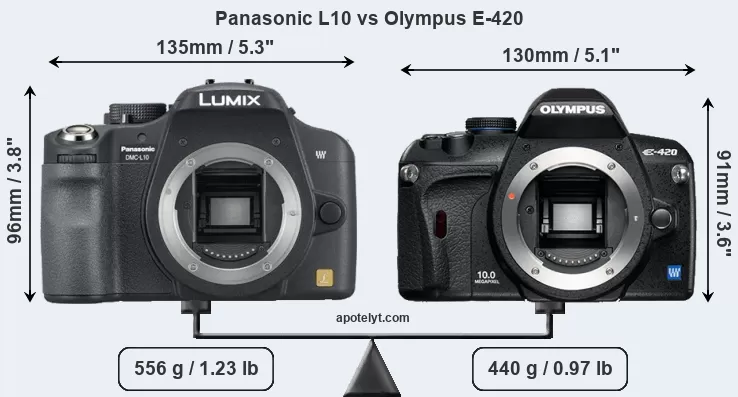
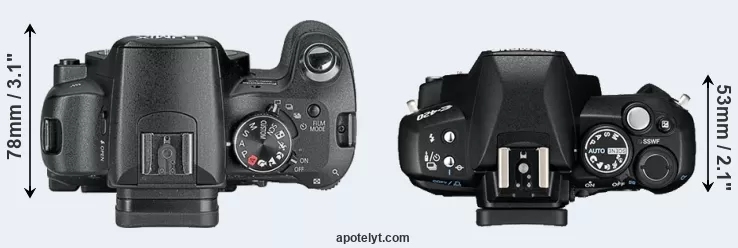
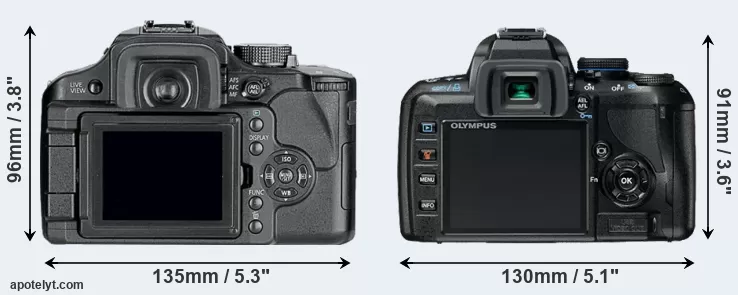
If the front view area (width x height) of the cameras is taken as an aggregate measure of their size, the Olympus E-420 is notably smaller (9 percent) than the Panasonic L10. Moreover, the E-420 is markedly lighter (21 percent) than the L10. In this context, it is worth noting that neither the L10 nor the E-420 are weather-sealed.
The above size and weight comparisons are to some extent incomplete since they do not consider the interchangeable lenses that both of these cameras require. In this particular case, both cameras feature the same lens mount, so that they can use the same lenses. You can compare the optics available in the Four Thirds Lens Catalog.
The following table provides a synthesis of the main physical specifications of the two cameras and other similar ones. If you would like to visualize and compare a different camera combination, you can navigate to the CAM-parator app and make your selection from a broad list of cameras there.

| Camera Model |
Camera Width |
Camera Height |
Camera Depth |
Camera Weight |
Battery Life |
Weather Sealing |
Camera Launch |
Launch Price (USD) |
Street Price |
||
|---|---|---|---|---|---|---|---|---|---|---|---|
| 1. | Panasonic L10 | 135 mm | 96 mm | 78 mm | 556 g | 450 | n | Aug 2007 | 599 | ebay.com | |
| 2. | Olympus E-420 | 130 mm | 91 mm | 53 mm | 440 g | 500 | n | Mar 2008 | 599 | ebay.com | |
| 3. | Nikon D40X | 124 mm | 94 mm | 64 mm | 522 g | 520 | n | Mar 2007 | 729 | ebay.com | |
| 4. | Nikon D60 | 126 mm | 94 mm | 64 mm | 522 g | 500 | n | Jan 2008 | 629 | ebay.com | |
| 5. | Olympus E-400 | 130 mm | 91 mm | 53 mm | 435 g | 500 | n | Sep 2006 | 699 | ebay.com | |
| 6. | Olympus E-410 | 130 mm | 91 mm | 53 mm | 435 g | 500 | n | Mar 2007 | 699 | ebay.com | |
| 7. | Olympus E-450 | 130 mm | 91 mm | 53 mm | 440 g | 500 | n | Mar 2009 | 499 | ebay.com | |
| 8. | Olympus E-520 | 136 mm | 92 mm | 68 mm | 535 g | 750 | n | May 2008 | 699 | ebay.com | |
| 9. | Olympus E-620 | 130 mm | 94 mm | 60 mm | 521 g | 500 | n | Feb 2009 | 699 | ebay.com | |
| 10. | Panasonic G1 | 124 mm | 84 mm | 45 mm | 360 g | 410 | n | Sep 2008 | 599 | ebay.com | |
| 11. | Panasonic G10 | 124 mm | 84 mm | 74 mm | 388 g | 380 | n | Mar 2010 | 499 | ebay.com | |
| 12. | Panasonic GF3 | 108 mm | 67 mm | 32 mm | 264 g | 300 | n | Jun 2011 | 549 | ebay.com | |
| 13. | Panasonic GF5 | 108 mm | 67 mm | 37 mm | 267 g | 360 | n | Apr 2012 | 499 | ebay.com | |
| 14. | Panasonic L1 | 146 mm | 87 mm | 64 mm | 606 g | 750 | n | Feb 2006 | 999 | ebay.com | |
| Note: Measurements and pricing do not include easily detachable parts, such as add-on or interchangeable lenses or optional viewfinders. | |||||||||||
The price is, of course, an important factor in any camera decision. The retail prices at the time of the camera’s release place the model in the market relative to other models in the producer’s line-up and the competition. The two cameras under review were launched at the same price and fall into the same market segment. Normally, street prices remain initially close to the MSRP, but after a couple of months, the first discounts appear. Later in the product cycle and, in particular, when the replacement model is about to appear, further discounting and stock clearance sales often push the camera price considerably down. Then, after the new model is out, very good deals can frequently be found on the pre-owned market.
Sensor comparison
The size of the sensor inside a digital camera is one of the key determinants of image quality. A large sensor will generally have larger individual pixels that offer better low-light sensitivity, provide wider dynamic range, and have richer color-depth than smaller pixels in a sensor of the same technological generation. Moreover, a large sensor camera will give the photographer more control over depth-of-field in the image and, thus, the ability to better isolate a subject from the background. On the downside, larger sensors tend to be associated with larger, more expensive camera bodies and lenses.
Both cameras under consideration feature a Four Thirds sensor and have a format factor (sometimes also referred to as "crop factor") of 2.0. Within the spectrum of camera sensors, this places the review cameras among the medium-sized sensor cameras that aim to strike a balance between image quality and portability. Both cameras feature a native aspect ratio (sensor width to sensor height) of 4:3.
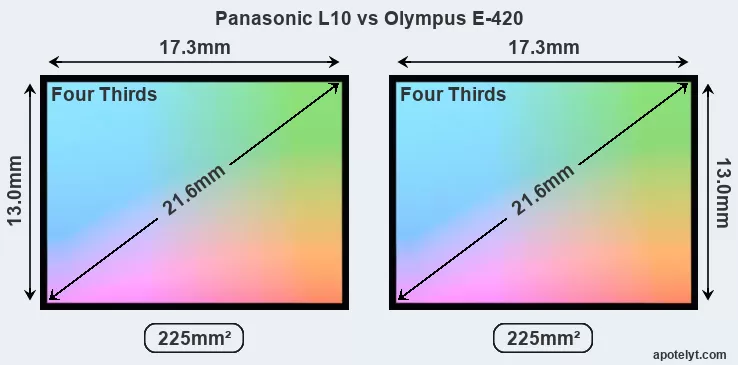
The two cameras under review do not only share the same sensor size, but also offer an identical resolution of 10 megapixels. This similarity in sensor specs implies that both the L10 and the E-420 have the same pixel density, as well as the same pixel size. It should, however, be noted that the E-420 is a somewhat more recent model (by 6 months) than the L10, and its sensor might have benefitted from technological advances during this time.
The Panasonic Lumix DMC- L10 has a native sensitivity range from ISO 100 to ISO 1600. The Olympus E-420 offers exactly the same ISO settings.
Technology-wise, both cameras are equipped with CMOS (Complementary Metal–Oxide–Semiconductor) sensors. Both cameras use a Bayer filter for capturing RGB colors on a square grid of photosensors. This arrangement is found in most digital cameras.
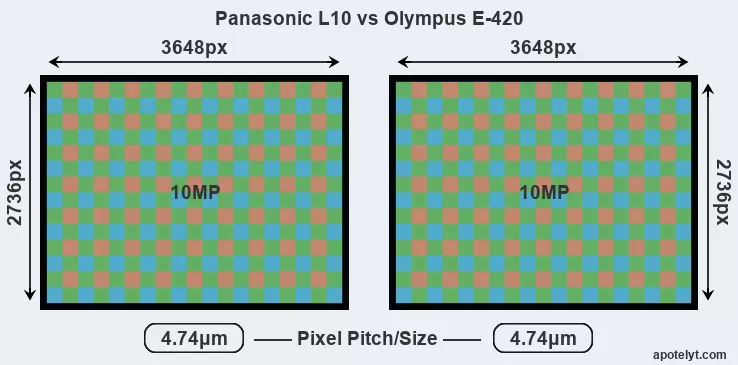
Consistent information on actual sensor performance is available from DXO Mark for many cameras. This service is based on lab testing and assigns an overall score to each camera sensor, as well as ratings for dynamic range ("DXO Landscape"), color depth ("DXO Portrait"), and low-light sensitivity ("DXO Sports"). The Overall DXO ratings for the two cameras under consideration are close, suggesting that they provide similar imaging performance. The following table provides an overview of the physical sensor characteristics, as well as the sensor quality measurements for a selection of comparators.

| Camera Model |
Sensor Class |
Resolution (MP) |
Horiz. Pixels |
Vert. Pixels |
Video Format |
DXO Portrait |
DXO Landscape |
DXO Sports |
DXO Overall |
||
|---|---|---|---|---|---|---|---|---|---|---|---|
| 1. | Panasonic L10 | Four Thirds | 10.0 | 3648 | 2736 | none | 21.3 | 10.8 | 429 | 55 | |
| 2. | Olympus E-420 | Four Thirds | 10.0 | 3648 | 2736 | none | 21.5 | 10.4 | 527 | 56 | |
| 3. | Nikon D40X | APS-C | 10.0 | 3872 | 2592 | none | 22.4 | 11.4 | 516 | 63 | |
| 4. | Nikon D60 | APS-C | 10.0 | 3872 | 2592 | none | 22.5 | 11.4 | 562 | 65 | |
| 5. | Olympus E-400 | Four Thirds | 10.0 | 3648 | 2736 | none | 21.0 | 10.6 | 127 | 53 | |
| 6. | Olympus E-410 | Four Thirds | 10.0 | 3648 | 2736 | none | 21.1 | 10.0 | 494 | 51 | |
| 7. | Olympus E-450 | Four Thirds | 10.0 | 3648 | 2736 | none | 21.5 | 10.5 | 512 | 56 | |
| 8. | Olympus E-520 | Four Thirds | 10.0 | 3648 | 2736 | none | 21.4 | 10.4 | 548 | 55 | |
| 9. | Olympus E-620 | Four Thirds | 12.2 | 4032 | 3024 | none | 21.3 | 10.3 | 536 | 55 | |
| 10. | Panasonic G1 | Four Thirds | 12.0 | 4000 | 3000 | none | 21.1 | 10.3 | 463 | 53 | |
| 11. | Panasonic G10 | Four Thirds | 12.0 | 4000 | 3000 | 720/30p | 21.2 | 10.1 | 411 | 52 | |
| 12. | Panasonic GF3 | Four Thirds | 12.0 | 4000 | 3000 | 1080/60i | 20.6 | 10.1 | 459 | 50 | |
| 13. | Panasonic GF5 | Four Thirds | 12.0 | 4000 | 3000 | 1080/60i | 20.5 | 10.0 | 573 | 50 | |
| 14. | Panasonic L1 | Four Thirds | 7.4 | 3136 | 2352 | none | 20.8 | 10.4 | 80 | 52 | |
| Note: DXO values in italics represent estimates based on sensor size and age. | |||||||||||
Feature comparison
Apart from body and sensor, cameras can and do differ across a range of features. The L10 and the E-420 are similar in the sense that both have an optical viewfinder. The latter is useful for getting a clear image for framing even in brightly lit environments. The viewfinders of both cameras offer the same field of view (95%), as well as the same magnification (0.46x). The adjacent table lists some of the other core features of the Panasonic L10 and Olympus E-420 along with similar information for a selection of comparators.

| Camera Model |
Viewfinder (Type or 000 dots) |
Control Panel (yes/no) |
LCD Specifications (inch/000 dots) |
LCD Attach- ment |
Touch Screen (yes/no) |
Max Shutter Speed * |
Max Shutter Flaps * |
Built-in Flash (yes/no) |
Built-in Image Stab |
||
|---|---|---|---|---|---|---|---|---|---|---|---|
| 1. | Panasonic L10 | optical | n | 2.5 / 207 | swivel | n | 1/4000s | 3.0/s | Y | n | |
| 2. | Olympus E-420 | optical | n | 2.7 / 215 | fixed | n | 1/4000s | 3.5/s | Y | n | |
| 3. | Nikon D40X | optical | n | 2.5 / 230 | fixed | n | 1/4000s | 3.0/s | Y | n | |
| 4. | Nikon D60 | optical | n | 2.5 / 230 | fixed | n | 1/4000s | 3.0/s | Y | n | |
| 5. | Olympus E-400 | optical | n | 2.5 / 215 | fixed | n | 1/4000s | 3.0/s | Y | n | |
| 6. | Olympus E-410 | optical | n | 2.5 / 215 | fixed | n | 1/4000s | 3.0/s | Y | n | |
| 7. | Olympus E-450 | optical | n | 2.7 / 215 | fixed | n | 1/4000s | 3.5/s | Y | n | |
| 8. | Olympus E-520 | optical | n | 2.7 / 215 | fixed | n | 1/4000s | 3.5/s | Y | Y | |
| 9. | Olympus E-620 | optical | n | 2.7 / 230 | swivel | n | 1/4000s | 4.0/s | Y | Y | |
| 10. | Panasonic G1 | 1440 | n | 3.0 / 460 | swivel | n | 1/4000s | 3.0/s | Y | n | |
| 11. | Panasonic G10 | 202 | n | 3.0 / 460 | fixed | n | 1/4000s | 2.6/s | Y | n | |
| 12. | Panasonic GF3 | none | n | 3.0 / 460 | fixed | Y | 1/4000s | 3.2/s | Y | n | |
| 13. | Panasonic GF5 | none | n | 3.0 / 920 | fixed | Y | 1/4000s | 4.0/s | Y | n | |
| 14. | Panasonic L1 | optical | n | 2.5 / 207 | fixed | n | 1/4000s | 3.0/s | Y | n | |
| Note: *) Information refers to the mechanical shutter, unless the camera only has an electronic one. | |||||||||||
The L10 writes its imaging data to SDHC cards, while the E-420 uses Compact Flash or xD Picture cards. The E-420 features dual card slots, which can be very useful in case a memory card fails. In contrast, the L10 only has one slot.
Connectivity comparison
For some imaging applications, the extent to which a camera can communicate with its environment can be an important aspect in the camera decision process. The table below provides an overview of the connectivity of the Panasonic Lumix DMC- L10 and Olympus E-420 and, in particular, the interfaces the cameras (and selected comparators) provide for accessory control and data transfer.

| Camera Model |
Hotshoe Port |
Internal Mic / Speaker |
Microphone Port |
Headphone Port |
HDMI Port |
USB Port |
WiFi Support |
NFC Support |
Bluetooth Support |
||
|---|---|---|---|---|---|---|---|---|---|---|---|
| 1. | Panasonic L10 | Y | - / - | - | - | - | 2.0 | - | - | - | |
| 2. | Olympus E-420 | Y | - / - | - | - | - | 2.0 | - | - | - | |
| 3. | Nikon D40X | Y | - / - | - | - | - | 2.0 | - | - | - | |
| 4. | Nikon D60 | Y | - / - | - | - | - | 2.0 | - | - | - | |
| 5. | Olympus E-400 | Y | - / - | - | - | - | 2.0 | - | - | - | |
| 6. | Olympus E-410 | Y | - / - | - | - | - | 2.0 | - | - | - | |
| 7. | Olympus E-450 | Y | - / - | - | - | - | 2.0 | - | - | - | |
| 8. | Olympus E-520 | Y | - / - | - | - | - | 2.0 | - | - | - | |
| 9. | Olympus E-620 | Y | - / - | - | - | - | 2.0 | - | - | - | |
| 10. | Panasonic G1 | Y | - / - | - | - | mini | 2.0 | - | - | - | |
| 11. | Panasonic G10 | Y | mono / - | - | - | mini | 2.0 | - | - | - | |
| 12. | Panasonic GF3 | - | stereo / mono | - | - | mini | 2.0 | - | - | - | |
| 13. | Panasonic GF5 | - | stereo / mono | - | - | mini | 2.0 | - | - | - | |
| 14. | Panasonic L1 | Y | - / - | - | - | - | 2.0 | - | - | - |
Both the L10 and the E-420 have been discontinued, but can regularly be found used on ebay. Neither of the two has a direct successor, so they represent the end of the respective camera lines from Panasonic and Olympus. Further information on the features and operation of the L10 and E-420 can be found, respectively, in the Panasonic L10 Manual (free pdf) or the online Olympus E-420 Manual.
Review summary
So what is the bottom line? Which of the two cameras – the Panasonic L10 or the Olympus E-420 – has the upper hand? Is one clearly better than the other? Below is a summary of the relative strengths of each of the two contestants.

Arguments in favor of the Panasonic Lumix DMC- L10:
- More flexible LCD: Has a swivel screen for odd-angle shots in portrait or landscape orientation.
- More selfie-friendly: Has an articulated screen that can be turned to be front-facing.
- More heavily discounted: Has been on the market for longer (launched in August 2007).

Advantages of the Olympus E-420:
- Larger screen: Has a bigger rear LCD (2.7" vs 2.5") for image review and settings control.
- Faster burst: Shoots at higher frequency (3.5 vs 3 flaps/sec) to capture the decisive moment.
- Less heavy: Has a lower weight (by 116g or 21 percent) and is thus easier to take along.
- Longer lasting: Gets more shots (500 versus 450) out of a single battery charge.
- Greater peace of mind: Features a second card slot as a backup in case of memory card failure.
- More modern: Was introduced somewhat (6 months) more recently.
If the number of relative strengths (bullet points above) is taken as a guide, the E-420 emerges as the winner of the match-up (6 : 3 points). However, the pertinence of the various camera strengths will differ across photographers, so that you might want to weigh individual camera traits according to their importance for your own imaging needs before making a camera decision. A professional wildlife photographer will view the differences between cameras in a way that diverges from the perspective of a family photog, and a person interested in architecture has distinct needs from a sports shooter. Hence, the decision which camera is best and worth buying is often a very personal one.
How about other alternatives? Do the specifications of the Panasonic L10 and the Olympus E-420 place the cameras among the top in their class? Find out in the latest Best DSLR Camera listing whether the two cameras rank among the cream of the crop.
In any case, while the comparison of technical specifications can provide a useful overview of the capabilities of different cameras, it says little about, for example, the shooting experience and imaging performance of the L10 and the E-420 in practical situations. User reviews that are available, for instance, at amazon can sometimes shed light on these issues, but such feedback is all too often partial, inconsistent, and inaccurate.
Expert reviews
This is where reviews by experts come in. The following table reports the overall ratings of the cameras as published by some of the major camera review sites (amateurphotographer [AP], cameralabs [CL], digitalcameraworld [DCW], dpreview [DPR], ephotozine [EPZ], photographyblog [PB]). As can be seen, the professional reviewers agree in many cases on the quality of different cameras, but sometimes their assessments diverge, reinforcing the earlier point that a camera decision is often a very personal choice.

| Camera Model |
AP score |
CL score |
DCW score |
DPR score |
EPZ score |
PB score |
Camera Launch |
Launch Price (USD) |
Street Price |
||
|---|---|---|---|---|---|---|---|---|---|---|---|
| 1. | Panasonic L10 | .. | 85/100 | .. | + | 3.5/5 | 4/5 | Aug 2007 | 599 | ebay.com | |
| 2. | Olympus E-420 | .. | 85/100 | .. | + + | 4/5 | 4.5/5 | Mar 2008 | 599 | ebay.com | |
| 3. | Nikon D40X | .. | 79/100 | .. | + + | 4/5 | 4/5 | Mar 2007 | 729 | ebay.com | |
| 4. | Nikon D60 | .. | 80/100 | .. | + + | 4/5 | 4.5/5 | Jan 2008 | 629 | ebay.com | |
| 5. | Olympus E-400 | .. | 85/100 | .. | .. | 4/5 | 4/5 | Sep 2006 | 699 | ebay.com | |
| 6. | Olympus E-410 | .. | 86/100 | .. | + + | 4/5 | 4.5/5 | Mar 2007 | 699 | ebay.com | |
| 7. | Olympus E-450 | .. | .. | .. | .. | 4/5 | 4/5 | Mar 2009 | 499 | ebay.com | |
| 8. | Olympus E-520 | .. | 87/100 | .. | + + | 4.5/5 | 4.5/5 | May 2008 | 699 | ebay.com | |
| 9. | Olympus E-620 | 3/5 | 88/100 | .. | 72/100 | 4.5/5 | 5/5 | Feb 2009 | 699 | ebay.com | |
| 10. | Panasonic G1 | .. | + + | .. | 70/100 | 4/5 | 4.5/5 | Sep 2008 | 599 | ebay.com | |
| 11. | Panasonic G10 | 3/5 | .. | .. | 70/100 | 4/5 | 4/5 | Mar 2010 | 499 | ebay.com | |
| 12. | Panasonic GF3 | 3/5 | 82/100 | .. | 71/100 | 4.5/5 | 4/5 | Jun 2011 | 549 | ebay.com | |
| 13. | Panasonic GF5 | 3/5 | .. | .. | .. | 4.5/5 | 4.5/5 | Apr 2012 | 499 | ebay.com | |
| 14. | Panasonic L1 | .. | 85/100 | .. | + | .. | 3.5/5 | Feb 2006 | 999 | ebay.com | |
| Note: (+ +) highly recommended; (+) recommended; (o) reviewed; (..) not available. | |||||||||||
The above review scores should be interpreted with care, though. The assessments were made in relation to similar cameras of the same technological generation. Thus, a score needs to be put into the context of the launch date and the launch price of the camera, and comparisons of ratings among very different cameras or across long time periods have little meaning. Also, please note that some of the review sites have changed their methodology and reporting over time.

Check L10 offers at
ebay.com

Check E-420 offers at
ebay.com
Other camera comparisons
Did this review help to inform your camera decision process? In case you would like to check on the differences and similarities of other camera models, just make your choice using the following search menu. There is also a set of direct links to comparison reviews that other users of the CAM-parator app explored.
- Canon 1D Mark II vs Olympus E-420
- Canon 1D Mark III vs Panasonic L10
- Canon 250D vs Panasonic L10
- Canon 300D vs Olympus E-420
- Canon G1 X Mark III vs Panasonic L10
- Canon T2i vs Olympus E-420
- Canon T3 vs Olympus E-420
- Fujifilm X100S vs Panasonic L10
- Nikon B600 vs Panasonic L10
- Olympus E-420 vs Ricoh GR III
- Olympus E-420 vs Sony NEX-F3
- Panasonic L10 vs Samsung NX1
Specifications: Panasonic L10 vs Olympus E-420
Below is a side-by-side comparison of the specs of the two cameras to facilitate a quick review of their differences and common features.
| Camera Model | Panasonic L10 | Olympus E-420 |
|---|---|---|
| Camera Type | Digital single lens reflex | Digital single lens reflex |
| Camera Lens | Four Thirds lenses | Four Thirds lenses |
| Launch Date | August 2007 | March 2008 |
| Launch Price | USD 599 | USD 599 |
| Sensor Specs | Panasonic L10 | Olympus E-420 |
| Sensor Technology | CMOS | CMOS |
| Sensor Format | Four Thirds Sensor | Four Thirds Sensor |
| Sensor Size | 17.3 x 13.0 mm | 17.3 x 13.0 mm |
| Sensor Area | 224.9 mm2 | 224.9 mm2 |
| Sensor Diagonal | 21.6 mm | 21.6 mm |
| Crop Factor | 2.0x | 2.0x |
| Sensor Resolution | 10 Megapixels | 10 Megapixels |
| Image Resolution | 3648 x 2736 pixels | 3648 x 2736 pixels |
| Pixel Pitch | 4.74 μm | 4.74 μm |
| Pixel Density | 4.44 MP/cm2 | 4.44 MP/cm2 |
| Moiré control | Anti-Alias filter | Anti-Alias filter |
| Movie Capability | no Video | no Video |
| ISO Setting | 100 - 1,600 ISO | 100 - 1,600 ISO |
| Image Processor | Venus | TruePic III |
| DXO Sensor Quality (score) | 55 | 56 |
| DXO Color Depth (bits) | 21.3 | 21.5 |
| DXO Dynamic Range (EV) | 10.8 | 10.4 |
| DXO Low Light (ISO) | 429 | 527 |
| Screen Specs | Panasonic L10 | Olympus E-420 |
| Viewfinder Type | Optical viewfinder | Optical viewfinder |
| Viewfinder Field of View | 95% | 95% |
| Viewfinder Magnification | 0.46x | 0.46x |
| LCD Framing | Live View | Live View |
| Rear LCD Size | 2.5inch | 2.7inch |
| LCD Resolution | 207k dots | 215k dots |
| LCD Attachment | Swivel screen | Fixed screen |
| Shooting Specs | Panasonic L10 | Olympus E-420 |
| Focus System | Phase-detect AF | Phase-detect AF |
| Continuous Shooting | 3 shutter flaps/s | 3.5 shutter flaps/s |
| Fill Flash | Built-in Flash | Built-in Flash |
| Storage Medium | SDHC cards | CF or XD cards |
| Single or Dual Card Slots | Single card slot | Dual card slots |
| Connectivity Specs | Panasonic L10 | Olympus E-420 |
| External Flash | Hotshoe | Hotshoe |
| USB Connector | USB 2.0 | USB 2.0 |
| HDMI Port | no HDMI | no HDMI |
| Wifi Support | no Wifi | no Wifi |
| Body Specs | Panasonic L10 | Olympus E-420 |
| Battery Type | Panasonic DMW-BLA13 | Olympus BLS-1 |
| Battery Life (CIPA) | 450 shots per charge | 500 shots per charge |
| Body Dimensions |
135 x 96 x 78 mm (5.3 x 3.8 x 3.1 in) |
130 x 91 x 53 mm (5.1 x 3.6 x 2.1 in) |
| Camera Weight | 556 g (19.6 oz) | 440 g (15.5 oz) |

Check L10 offers at
ebay.com

Check E-420 offers at
ebay.com
Did you notice an error on this page? If so, please get in touch, so that we can correct the information.

